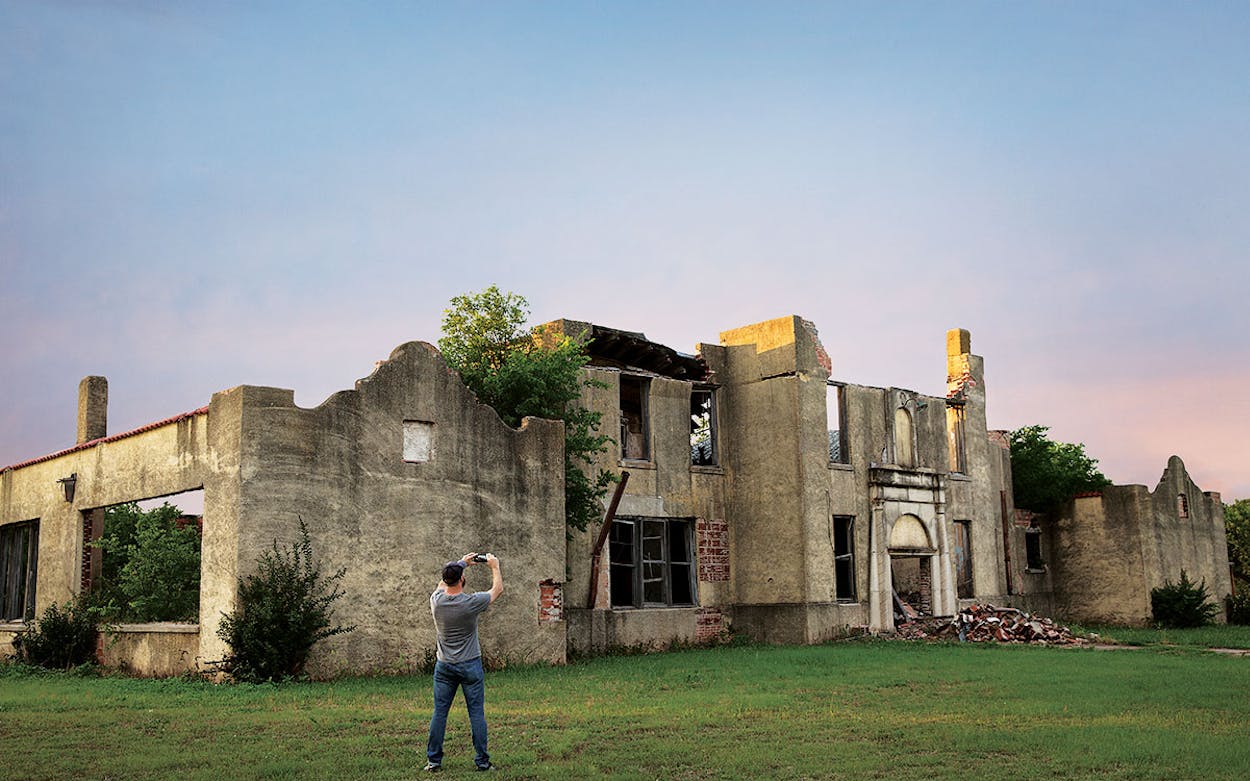If you’re driving from Austin to Dallas and want to spend as little time on Interstate 35 as possible, you might find yourself traveling along back roads that will take you through Lampasas, Gatesville, and Cleburne. Eighteen miles past Gatesville, in the southernmost corner of Bosque County, as you move through the dying hamlet of Mosheim, you might notice a startling sight: a crumbling structure that looks like the Alamo on performance-enhancing drugs. The Alamo has one story; this one has two. The Alamo has just one rounded parapet over the door; this one has one on each corner of the building’s frontage.
What was that? you might wonder. Some eccentric’s dilapidated mansion? A bank in a state of terminal disrepair? A decommissioned hotel?
In fact, the building is Mosheim’s old public school, a wondrous example of the sorts of ambitions that have long defined Texas, even when those ambitions fell prey to the twentieth-century migration from the countryside to the cities.
According to the Clifton Record, the closest newspaper in the area, the Mosheim School was likely designed in the Roaring Twenties and scheduled to be dedicated on December 5, 1930, as the Great Depression was deepening across the country. Mosheimers were supposed to celebrate all weekend long, with bands; boys’ and girls’ basketball games against teams from nearby Morgan; physical education demonstrations; speeches by the architect, contractor, and superintendent of schools; and two plays, each potentially more offensive than the other. One of these dramas, The Fortunate Calamity, was described as “a gripping story illustrating practical life” and starred poor Miss Gladys Anderson as “just a plain girl.” That production was supposed to be followed by “a Negro comedy which will bring a laugh from the most serious.” Unfortunately, bad weather pushed the big weekend back to December 12; it’s unclear how many of these festivities ultimately took place.
Ominous start or no, hopes were high. Before the school opened, the superintendent took to the local paper to boast of the school’s “progressive” educational methods and note that the “seven classrooms, study hall, auditorium, library, book depository, lavatories, and superintendent’s office” would “meet the needs of Mosheim’s future citizens” and enable teachers to train “the boys and girls who will make the America of tomorrow.” Bosque County, it should be noted, was home to the state’s greatest concentration of Norwegian settlers—to this day, Clifton bills itself as “the Norwegian Capital of Texas”—and many of the residents seem to have brought their Scandinavian faith in progress with them. “Mosheim people are justly proud of their new school building,” reported the Record. (The mission-style design was “unique for a country school of that period,” according to the website lost-texas.com.)
But despite all this optimism, future citizens never came in any large numbers. According to the Texas State Historical Association, Mosheim’s population peaked at about two hundred in the forties and fifties; it appears that the school never had a graduating class in the double digits.
Jamie Morris, a 54-year-old HR administrative assistant who lives in Farmersville, was a frequent visitor to the school in the seventies, by which time it was closed. She and her siblings, descendants of Norwegian families with roots in the area, were trucked in from Fort Worth to summer with their grandparents. Morris recalls that there wasn’t much for them to do in Mosheim, other than fish in a nearby creek, walk up and down the road, and toil in their grandparents’ garden.
And then there was the school, which her father had attended, years earlier. “We could still go upstairs and play around in the classrooms,” she says. “It was like they had just closed the doors and walked away. There were still books in there and a jar with a spider suspended in liquid in the science room.”
It’s hard to tell when the school closed its doors for good, but in 1960, the nine high-school-age students still there were dispersed to nearby schools so Mosheim could focus its dwindling resources on the younger children. By 1969 the building seemed to be functioning as a community center, hosting events like a “fun night,” where visitors were encouraged to “bring a friend, cards or dominoes, and enjoy the evening.” Today, Mosheim’s population is estimated at about fifty, and the only mentions of the school to be found in post-1970 newspaper databases seem to be citations in obituaries of former teachers and students.
“As we became teenagers, we quit going as much,” Morris says. Her trips to Mosheim grew infrequent—family reunions, mostly. The last time her family visited was five years ago. On that occasion, Morris and her siblings didn’t attempt to enter their grand old playhouse; they just peered through the windows and remembered the good times they’d once had inside.
Today, if you stop your car and step out to get a better look at the school, you’ll see that the structure is returning to dust; it now more closely resembles the humpless Alamo of 1836 than the one we know and revere today. The magnificent central parapet that once crowned the building is lying in heaps, just inside and outside what remains of the Spanish-style doorway. Inside, the floors are covered with nail-studded boards and pressed-metal ceiling tiles. Most of the old classroom walls are tagged with graffiti, though not with profanity, as one might expect. Instead, there are spray-painted motivational quotes advising trespassers to “Open your mind before your mouth” and “Live Free.” Another simply states, “Beauty in the forgotten.”
As you step back into your car and take one last look at this failing structure, you might notice a solitary vulture perched just yards away from where that reminder of Texan defiance presided for over eighty years.








